How Netwealth Is Managing Investment Portfolios Now
While we invest primarily in passive instruments such as ETFs, our approach to managing money is far from static. This allows us to respond proactively to a frequently shifting economic and market environment and be better positioned to help our clients reach their financial goals.
Reviewing and adapting to changing circumstances
An important part of our investment approach is the regular review of portfolios’ strategic asset allocations to reflect changes in market conditions, with a particular eye on valuations. Early in 2021, for example, as part of a strategic review we carried out then, we reduced ‘core’ government and high-quality corporate bond duration on portfolios (for example, by holding 2-year instead of 10-year bonds), on account of their low income yields. We preferred instead to allocate more exposure to targeted parts of the bond market as well as introducing other diversifying assets, such as gold.
While our investment approach is to manage allocations thoughtfully and actively, we are unlikely to shift completely away from such an important strategic anchor on portfolios as bond markets. Instead, we chose to invest less in the parts of the market worst affected by conditions, effectively smoothing overall portfolio returns as a result.
Incremental cyclical exposure (where assets are affected by changes to the wider economy) to broader commodities on the expectation of persistent inflationary pressure has also served to offset the shift to higher yields. The later additions of local currency denominated emerging market bonds and high yield corporate bonds have also benefited returns across the portfolio range. We have resisted the opportunity to date of investing in assets with weak liquidity profiles, or alternatives such as infrastructure and real estate which have been in the eye of the storm despite the premise of inflation-linked cashflows.
Within equity markets, we have often referenced the divergent performance of the US with the rest of the world. Since the Global Financial Crisis, the US market has outperformed strikingly thanks to a strong domestic economy and resulting confidence of a growing consumer sector, a dynamic capital market environment and a dominant consumer technology sector which has been able to deliver emphatic profits growth while other areas saw anaemic returns.
It remains vitally important to recognise this strength but balance it with other markets and their divergent characteristics. At times, we have adjusted allocations to reflect variations in outlook, whether on a strategic or more cyclical basis. Currently, we believe that the concentration and expensiveness of the small cohort of US mega-cap stocks could be a meaningful source of volatility for markets in the future.
After the UK, the US is still the largest regional allocation in portfolios, but it is smaller than previously, and we have diluted exposure to the biggest stocks with the Xtrackers S&P 500 Equal Weight ETF. An equal weighted ETF invests equally in companies in an index irrespective of their size, and therefore can reduce the risk of investing in an index if you believe its larger companies are overvalued.
Our outlook
As we look to the second half of the year, there are reasons to be more positive on markets, but as ever, risks remain. As a result, our portfolios are positioned close to their strategic allocations. On the positive side, previous market falls have reset valuations to more attractive levels.
Returns on cash are attractive now, but should the inflation backdrop continue to improve, the risk is that holders of cash will soon find they are unable to invest at current market pricing; there is an opportunity cost in sitting on the sidelines.
Bond markets have re-set. Central bankers’ belated resolve against inflation means that yields provide more of a cushion to manage future uncertainty. In the US, there is an expectation that interest rates will soon fall as concerns of a slowdown persist. However, Treasury bonds now offer a higher yield over expected inflation than has been available for a long time. It remains to be seen whether interest rates will peak soon, or plateau at these higher levels, but investors are now being compensated to find out.
US Treasury bond yields

Source: Bloomberg, with Netwealth calculations.
UK bonds have continued to underperform, as market participants expect the Bank of England has more work to do given current second round inflation pressures, as discussed here. We expect that at some point this will create good opportunities for the future.
We are less exposed to credit risk than usual. The all-in yields now available are more attractive than historic levels. However, for multi-asset investors the benefits of incremental gains in yield above government bonds are less important than the way we expect corporate bonds to behave in relation to other asset classes.
Within equities, we are often asked about allocations to the UK market. Ultimately, for a combination of reasons the UK remains attractively priced relative to its history and to other markets. We view the allocation as offering exposure that are very complementary to the dominant US market: attractive valuations in unfashionable sectors with less attractive prospects for sustained earnings growth. Scepticism around domestic economic performance and capital market dynamics signify that international investors are happy to ignore it, meaning that any catalyst to improving sentiment could have a big impact.
An approach proven to work
It’s clear the past couple of years has been an unusual time for most investment markets, and may have challenged the expectations of investors. It’s also evident that a strategic approach – with low embedded costs, and actively and thoughtfully managed passive instruments – can curtail relative losses in difficult times while also outperforming during more favourable environments. Our level of outperformance since inception is testament to this thesis.
We work hard to prepare for multiple potential outcomes and to help you meet your long-term financial objectives. To find out more, please get in touch.
Please note, the value of your investments can go down as well as up.